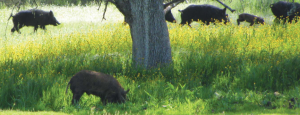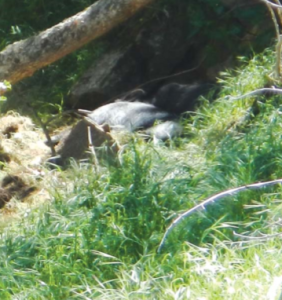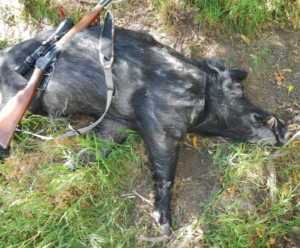Hunting Summer Swine
A QUARTER CENTURY OF PURSUING PIGS HAS LED TO GOOD INSIGHTS FOR HOW TO HUNT IN THE HIGH HEAT
By Tim E. Hovey
I’ve been hunting wild pigs in California for over 25 years, and in that time, I’ve chased them during all seasons.
Winter and spring hogs can be found moving at all times of the day during the cooler daytime conditions. However, when the weather heats up and the days get longer, wild pigs will adjust their movement patterns and are less likely to be encountered during the heat of the day. If you adjust your hunting tactics and know what to look for, chasing late-summer pigs can be exciting and successful.
FIND THE WATER
During hotter periods of the year, all mammals need to seek out water frequently. Most animals will visit existing water sources and usually bed down somewhere close by. When the greenery starts to dry up in the lowlands and the days get hotter, my first order of business when hunting pigs is to locate the water.
If you stand and look out over any terrain during dry periods of the year, the presence of water isn’t difficult to spot. Springs and seeps that force water to the surface or even close to the surface will maintain greener vegetation than dry areas. I like to find an elevated location where I can get a good view of the terrain I’ll be hunting and glass for green areas. I’ll look in valleys or rocky bluffs to see where the vegetation is greenest. Green vegetation almost always means water.

After locating potential water sources, I’ll check and see if these areas are being used regularly. From a distance, I can ascertain if the trails leading to the water look fresh. If I can easily access the water hole, I’ll examine the tracks around the shore for recent activity.
A water source that doesn’t offer any quality cover nearby may be visited occasionally, but for the most part, I don’t concentrate my scouting efforts at these locations.
Areas that have quality bedding habitat close to available water are your best bet. If these locations are a bit remote or tough to access, they are a top priority for me to hunt. Pigs like to bed in thick cover to stay hidden, and if you find a spot that looks absolutely nasty to access, it may be just what wild pigs are looking for.
MOVE EARLY, MOVE LATE
During warmer parts of the year, wild pigs will become nocturnal and usually feed in the evening. Hunters getting to the hunting grounds early can intercept pigs moving from feeding areas and back to their beds. Pigs can also be spotted on the run near sundown. In either case, these window of opportunity are very brief, and unless you are familiar with feeding and bedding areas, success will be limited.
As the vegetation dries out in the lower valleys, groups of pigs will head to higher elevations to seek out greener vegetation to feed on. Lone adult boars, usually separated from the group, will occasionally bed down at lower elevations if they find adequate water and cover to carry them through the day. When the days heat up and pigs wait it out in the thick stuff, I really enjoy picking apart the terrain and identifying these resting areas to kick through.
CHECKING BEDS
When I spot a water area that looks promising, I try and develop two plans of approach to accommodate differing wind directions. I usually do this from a distance and then choose an approach once I test the wind at the area. With the wind in my face, I’ll slowly stalk in near the bedding area. I like to try and approach from the top and visualize or identify escape routes for both the pigs and myself.

Once I get close, I spend a little time looking for fresh sign before I kick through the vegetation. Fresh tracks and scat will give you an idea if the area is being used. Bedded pigs will hold tight to cover and may not break cover until you’re nearly on top of them.
Shot opportunities may be quick and brief. This type of hunting favors a short-barreled, quick-swinging firearm. That’s why this year – when the weather started heating up – I decided to dust off an old rifle I hadn’t used in a long time.
HUNTING WITH AN OLD FAVORITE
In 1990, I was using the only rifle I owned for hunting big game, a Marlin lever-action .30-30. When I pulled it out for a pig hunt, the guide laughed at my stubby brush gun.
Before we got started, he laid out some very specific rules for my lever gun and me. My shots were to be limited to inside 100 yards and the pig needed to be still and broadside for me to even think about taking a shot.
I ended up killing a fat sow as the guide stood right next to me. I hit the pig in the back of the head, offhand, and as she ran straight away from us 100 yards out.
The guide never said another word about my Marlin.
But after I returned home, I stored the rifle in the safe and moved on to other calibers.
This year, I have been able to sneak very close to bedded animalsand have kicked pigs up anywhere from 30 yards to a few feet. For this reason, I decided to dust off the old lever gun and carry it with me while hunting the thick stuff. I hadn’t hunted with the Marlin since 1990 and was hoping I’d get a chance to once again put a pig on the ground with it.
In June, I met up with my friend Mike and we headed in to our hunting area around noon.
The plan was to head into a steep canyon where I knew pigs had been active in recent weeks. Playing the wind, I set up Mike near the bottom of the creek that overlooked a wellworn game trail. I left him there and began to hike the adjacent ridge. My plan was to get to the top, drop into the creek and slowly kick through the creek bottom. My intention was hopefully sending pigs downstream towards Mike. With the temperature approaching 100 degrees, I knew that not much movement would be taking place voluntarily.
I was following a well-used game trail and was about a half-mile up the ridge when I decided to take a water break. I bent down to place my binoculars on the ground when a large animal broke from cover a mere 8 feet from where I was standing. I had the rifle up quickly, but the large boar dropped into the adjacent drainage and out of sight in a heartbeat.

When I last saw him, he was headed in the opposite direction of where Mike was set up and had dropped into a different creek bottom. I knew Mike would never see this pig, considering it was this far up the ridge and knowing his escape direction.
I ran to the edge of the canyon and waited. The creek was very narrow and I figured I could get a clear shot as the boar escaped up the opposite ridge. Thirty seconds passed and nothing appeared. I took a few more steps and looked into the creek bottom. The boar was standing in deep cover broadside. My wind was good and he appeared to have no idea exactly what had kicked him out of his bed.
I raised the Marlin and easily found the pig in the scope. His vitals were covered up by thick vegetation and I needed him to take two steps for a clear shot. Within seconds, he took exactly two steps and stopped. I adjusted, found the crease behind the shoulder and dropped him there at 80 yards. I ejected the shell, picked up the brass and instantly realized that I had just killed my first big animal with my lever gun in over a quarter of a century.
BEING SNEAKY PAYS OFF Sneaking close to bedded pigs is one of my favorite ways to pursue wild hogs in California. If you spend time glassing areas and identifying wellused watering spots during the warmer months, pigs will be bedded nearby. All you have to do is find them.
Wild pigs will adjust their movement patterns as temperatures rise. As they avoid the heat, they’ll feed more during evening hours and move to and from bedding areas very early and very late.
If you feel like extending your hunting opportunities well beyond the narrow movement windows, try seeking out summer hogs in their bedding areas. Hearing a 200-pound animal break cover right near your feet will definitely get your heart pumping. CS


